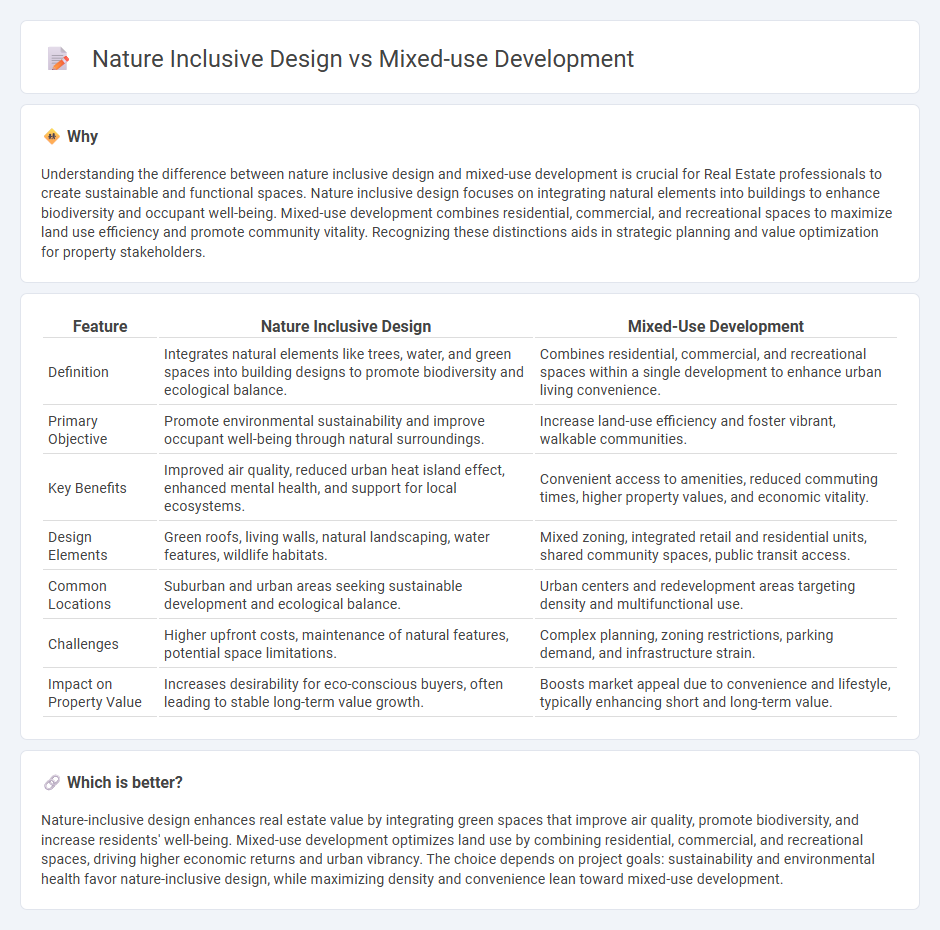
Nature-inclusive design integrates natural elements like green roofs, native vegetation, and water management systems into real estate projects to promote biodiversity and enhance environmental sustainability. Mixed-use development combines residential, commercial, and recreational spaces within a single area, fostering walkability and reducing urban sprawl. Explore how both strategies reshape modern real estate landscapes and drive sustainable urban growth.
Why it is important
Understanding the difference between nature inclusive design and mixed-use development is crucial for Real Estate professionals to create sustainable and functional spaces. Nature inclusive design focuses on integrating natural elements into buildings to enhance biodiversity and occupant well-being. Mixed-use development combines residential, commercial, and recreational spaces to maximize land use efficiency and promote community vitality. Recognizing these distinctions aids in strategic planning and value optimization for property stakeholders.
Comparison Table
| Feature | Nature Inclusive Design | Mixed-Use Development |
|---|---|---|
| Definition | Integrates natural elements like trees, water, and green spaces into building designs to promote biodiversity and ecological balance. | Combines residential, commercial, and recreational spaces within a single development to enhance urban living convenience. |
| Primary Objective | Promote environmental sustainability and improve occupant well-being through natural surroundings. | Increase land-use efficiency and foster vibrant, walkable communities. |
| Key Benefits | Improved air quality, reduced urban heat island effect, enhanced mental health, and support for local ecosystems. | Convenient access to amenities, reduced commuting times, higher property values, and economic vitality. |
| Design Elements | Green roofs, living walls, natural landscaping, water features, wildlife habitats. | Mixed zoning, integrated retail and residential units, shared community spaces, public transit access. |
| Common Locations | Suburban and urban areas seeking sustainable development and ecological balance. | Urban centers and redevelopment areas targeting density and multifunctional use. |
| Challenges | Higher upfront costs, maintenance of natural features, potential space limitations. | Complex planning, zoning restrictions, parking demand, and infrastructure strain. |
| Impact on Property Value | Increases desirability for eco-conscious buyers, often leading to stable long-term value growth. | Boosts market appeal due to convenience and lifestyle, typically enhancing short and long-term value. |
Which is better?
Nature-inclusive design enhances real estate value by integrating green spaces that improve air quality, promote biodiversity, and increase residents' well-being. Mixed-use development optimizes land use by combining residential, commercial, and recreational spaces, driving higher economic returns and urban vibrancy. The choice depends on project goals: sustainability and environmental health favor nature-inclusive design, while maximizing density and convenience lean toward mixed-use development.
Connection
Nature-inclusive design in real estate enhances mixed-use developments by integrating green spaces, biodiversity, and sustainable landscaping into urban environments, creating healthier and more attractive living and working areas. This synergy promotes ecological balance, improves air quality, and supports community well-being while increasing property values and market appeal. Mixed-use developments benefit from nature-inclusive design through reduced urban heat islands and enhanced social interaction, fostering vibrant, resilient neighborhoods.
Key Terms
Zoning
Mixed-use development integrates residential, commercial, and recreational zones within a single area to enhance urban density and reduce commute times, promoting sustainable city living. Nature-inclusive design emphasizes zoning that preserves green spaces, natural habitats, and biodiversity, ensuring urban ecosystems thrive alongside built environments. Explore the distinct zoning strategies that balance urban growth with environmental stewardship to create resilient communities.
Biodiversity
Mixed-use developments integrate residential, commercial, and recreational spaces to optimize land use while supporting urban biodiversity through green roofs, community gardens, and wildlife corridors. Nature-inclusive design prioritizes biodiversity by incorporating native vegetation, natural habitats, and ecological connectivity to enhance ecosystem services and resilience. Explore how these innovative approaches balance urban growth with conservation to foster sustainable, biodiverse environments.
Urban Integration
Mixed-use development enhances urban integration by combining residential, commercial, and recreational spaces, promoting walkability and reducing commute times, which supports vibrant community life. Nature inclusive design incorporates green infrastructure such as parks, green roofs, and urban wetlands, improving biodiversity and climate resilience within urban areas. Explore how these approaches redefine urban living and contribute to sustainable city planning.
Source and External Links
Supporting Active Living Through Mixed-Use Developments - Mixed-use developments support active living by combining multiple uses like residential, commercial, and civic spaces, promoting physical activity and economic opportunities.
Benefits of Mixed-Use Development in Urban Areas - Mixed-use developments efficiently combine residential, commercial, and sometimes industrial spaces, fostering vibrant and sustainable urban communities.
Mixed-use development - Mixed-use development involves integrating multiple land uses like residential, commercial, and cultural into a single area or building, enhancing urban livability and functionality.
 dowidth.com
dowidth.com